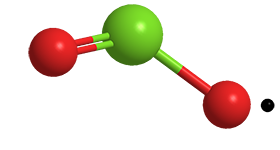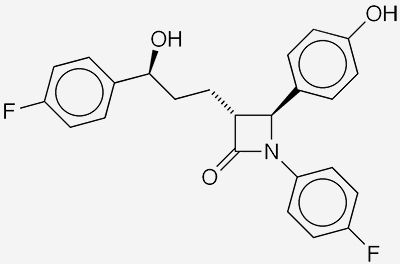What molecule am I?


Chlorine dioxide (ClO2), also known as chlorine peroxide and chlorine(IV) oxide, is a low-boiling red-brown liquid and yellow-green gas. It has an odd number of valence electrons, which makes it an unusual stable free radical and therefore paramagnetic.
In 1811 or 1814 (accounts vary), pioneering English chemist Sir Humphry Davy discovered ClO2 when he added sulfuric acid to potassium chlorate. This procedure is often used today, along with reactions of sodium chlorite with chlorine, sodium hypochlorite, hydrochloric acid, or sulfuric acid. For safety reasons, ClO2 is frequently generated just before use rather than shipped from a manufacturing plant.
ClO2 has multiple uses, including bleaching agent for paper pulp, leather, textiles, and flour; water purification; bactericide and antiseptic agent; and oxidizing reagent. It reacts violently with organic materials and is often prepared and handled as a 0.3%–0.5% aqueous solution. Its worldwide production value for 2023 is estimated at US$1 billion.
For additional information about ClO2. See the ScienceDirect topics page.
Chlorine dioxide hazard information
| Hazard class* | GHS code and hazard statement | |
|---|---|---|
| Acute toxicity, oral, category 3 | H301—Toxic if swallowed | |
| Skin corrosion/irritation, category 2 | H315—Causes skin irritation | |
| Serious eye damage/eye irritation, category 1 | H318—Causes serious eye damage | |
| Acute toxicity, inhalation, category 2 | H330—Fatal if inhaled | |
| Specific target organ toxicity, single exposure, category 2 | H371—May cause damage to respiratory system, blood, or kidneys | |
| Specific target organ toxicity, repeated exposure, category 2 | H373—Causes damage to blood or kidneys through prolonged or repeated exposure | |
*Globally Harmonized System (GHS) of Classification and Labeling of Chemicals. Explanation of pictograms.
Ezetimibe1 is a medication that was originally developed in the 1990s by Schering (Kenilworth, NJ) to treat high serum cholesterol in conjunction with statins. It was first described in World Patent WO9508532 (1995) that covered hydroxy-substituted azetidinone compounds.

In recent years, ezetimibe has been examined as a possible treatment for Alzheimer's disease and other neurological disorders. Earlier this year, Robert J. Shmookler Reis, Srinivas Ayyadevara, and co-workers at the University of Arkansas for Medical Sciences (Little Rock) reported that ezetimibe lowers the risk of Alzheimer’s and related dementias by >7-fold in animal and cultured-cell models. The authors found that ezetimibe reduces protein aggregation by disrupting adhesion between hexokinase 1 and 14-3-3G/γ proteins.
1. CAS Reg. No. 163222-33-1.
Molecule of the Future
Once a month we bring you a newly discovered or developed molecule that has important implications for the future of chemistry or society in general. Look for it the third week of each month. Learn more about this month's Molecule of the Future below.
We're looking for more molecules of the future!
Do you have a suggestion for the next molecule of the future? Send your idea to MOTW.
This molecule was suggested by a reader. We present almost all of the molecules suggested by our readers. If you have a molecule you would like us to consider, please send us a message. And thank you for your interest in Molecule of the Week! —Ed.
Chlorine dioxide
fast facts
| CAS Reg. No. | 10049-04-4 |
| SciFindern name | Chlorine oxide (ClO2) |
| Empirical formula | ClO2 |
| Molar mass | 67.45 g/mol |
| Appearance | Yellow-green gas |
| Boiling point | 11 °C |
| Water solubility | 8 g/L (20 °C) 3 g/L (25 °C) |

Learn more about this molecule from CAS, the most authoritative and comprehensive source for chemical information.
Molecule of the Week needs your suggestions!
If your favorite molecule is not in our archive, please send us a message. The molecule can be notable for its current or historical importance or for any quirky reason. Thank you!
Stay Ahead of the Chemistry Curve
Learn how ACS can help you stay ahead in the world of chemistry.

